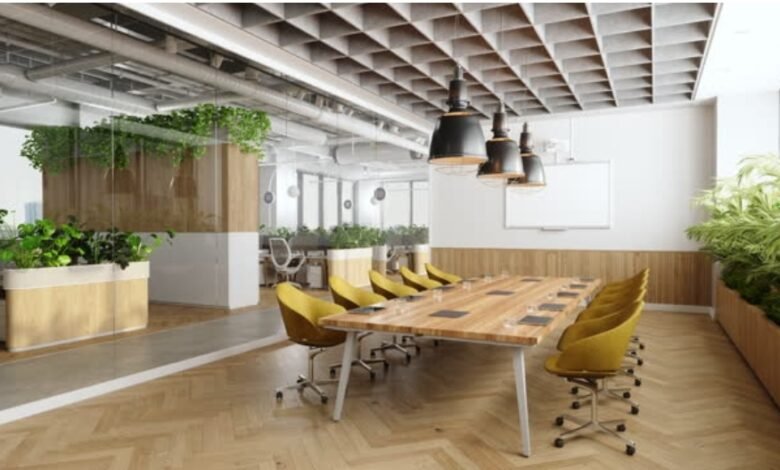Office Elegance: Creating a Productive Paradise with Office Interior Mastery

In the fast-paced world of business, the design and layout of an office space play a crucial role in influencing productivity, creativity, and employee well-being.
An elegantly designed office not only reflects a company’s values and culture but also serves as a motivational space for employees to thrive.
This article delves into the realm of office interior mastery, exploring key elements and strategies to create a productive paradise that fosters creativity, collaboration, and overall success.
The Importance of Office Design in the Modern Workplace
Setting the Tone for Success
The physical environment in which employees work has a profound impact on their performance and job satisfaction. An office space that exudes elegance sets a positive tone, signaling to employees that their work is valued and that the company prioritizes a conducive atmosphere for success.
Enhancing Productivity Through Design
Well-thought-out office design goes beyond aesthetics; it directly influences productivity. The strategic placement of workstations, the incorporation of ergonomic furniture, and the use of natural light can significantly contribute to an environment that promotes focus and efficiency.
Boosting Employee Morale and Well-being
A visually appealing and comfortable workspace contributes to employee well-being. A carefully designed office can reduce stress, enhance mood, and create a positive atmosphere. These factors, in turn, lead to increased job satisfaction and employee retention.
Mastering the Art of Office Interior Design
Understanding Your Company’s Culture
Before embarking on an office interior redesign, it’s crucial to understand and embrace the unique culture of your company. The office space should align with the values, mission, and identity of the organization.
A tech startup may opt for a modern, open-space layout, while a law firm may lean towards a more traditional and formal design.
The Role of Color Psychology
Color has a profound impact on human psychology, and incorporating the right colors into the office design can evoke specific emotions and enhance productivity. For instance, blue is associated with calmness and focus, making it suitable for areas where concentration is crucial.
On the other hand, green can promote a sense of tranquility and balance, making it ideal for break or collaboration spaces.
Lighting as a Design Element
Proper lighting is a key component of office interior mastery. Natural light not only reduces the reliance on artificial lighting but also positively affects mood and circadian rhythms.
Well-placed windows, skylights, and strategically positioned artificial lighting can create a well-lit and energetic workspace.
The Mirror Effect: Enhancing Space and Atmosphere
Incorporating Bunny Williams mirrors into the office design can serve as a powerful tool to enhance space and atmosphere. Mirrors create an illusion of larger space, making even smaller offices feel more open and inviting.
Additionally, mirrors can reflect natural light, brightening up darker corners and contributing to an overall sense of vibrancy within the workspace.
Ergonomics: A Cornerstone of Office Interior Mastery
The Importance of Comfortable Workstations
Ergonomics plays a pivotal role in office design, focusing on creating work environments that are comfortable and efficient.
Ergonomic furniture, such as adjustable desks and chairs, helps prevent musculoskeletal disorders and enhances overall well-being. A comfortable workstation can contribute to increased productivity and reduced absenteeism.
Incorporating Movement into the Workplace
Modern office design emphasizes the importance of movement throughout the workday. Standing desks, ergonomic chairs, and collaborative spaces encourage employees to move and interact. This not only has health benefits but also fosters a dynamic and vibrant work environment.
Personalization and Flexibility
Recognizing that each employee has unique preferences and work styles, office interior mastery involves providing options for personalization and flexibility.
Adjustable lighting, customizable workspaces, and adaptable furniture arrangements empower employees to create a work environment that suits their individual needs and preferences.
Creating Collaborative Spaces for Innovation
Open-Plan Layouts: Pros and Cons
Open-plan layouts have become synonymous with modern office design, promoting collaboration and communication. However, striking the right balance is crucial, as an overly open space can lead to distractions and a lack of privacy.
Thoughtful design, incorporating collaborative zones and private work areas, can maximize the benefits of an open-plan layout.
Designing Inspiring Meeting Rooms
Meetings are integral to the functioning of any organization, and the design of meeting rooms can significantly impact their effectiveness.
Incorporating technology, comfortable seating, and inspiring aesthetics can transform meeting rooms into dynamic spaces that foster creativity and innovation.
Nurturing Informal Collaboration
Beyond formal meeting spaces, creating areas for informal collaboration is equally important. Lounge areas, coffee corners, and breakout zones provide employees with opportunities to engage in spontaneous discussions, fostering a culture of innovation and idea-sharing.
Balancing Privacy and Openness
Designing Private Workspaces
While collaboration is essential, recognizing the need for privacy is equally important.
Designing private workspaces, whether individual offices or secluded cubicles, provides employees with the necessary quietude to focus on tasks that require concentration. Striking a balance between open and private spaces is key to a well-designed office.
Acoustic Considerations
Noise levels can significantly impact productivity and concentration. Incorporating office acoustics design elements, such as sound-absorbing materials, can mitigate distractions and create a more conducive work environment.
From carpets to acoustic panels, thoughtful design choices can make a substantial difference in the acoustic quality of the office.
Integrating Technology for Seamless Operations
Smart Office Solutions
The integration of technology into office design goes beyond the basic infrastructure. Smart office solutions, such as IoT devices, automated climate control, and digital collaboration tools, enhance efficiency and create a seamless working experience.
These technologies not only streamline operations but also contribute to a modern and forward-thinking office atmosphere.
Embracing Sustainable Practices
As businesses increasingly prioritize sustainability, office interior mastery involves incorporating eco-friendly design elements.
From energy-efficient lighting to recycled materials, adopting sustainable practices not only aligns with corporate social responsibility but also creates a healthier and more environmentally conscious workspace.
The Role of Art and Aesthetics in Office Interior Mastery
Incorporating Art for Inspiration
Art has the power to inspire and stimulate creativity. Integrating artworks, sculptures, and murals into the office design adds a layer of sophistication while creating a visually engaging environment.
Art can serve as a conversation starter, promoting a sense of culture and identity within the workplace.
Aesthetic Elements for a Cohesive Design
Consistency in design elements is crucial for creating a cohesive and visually appealing office space. From furniture styles to color schemes, maintaining a unified aesthetic enhances the overall look and feel of the workspace.
Attention to detail in the selection of materials and finishes contributes to a polished and elegant design.
The Future of Office Interior Mastery
Adapting to Remote Work Trends
The rise of remote work has prompted a reevaluation of traditional office design concepts. As companies embrace flexible work arrangements, the role of the office is evolving into a hub for collaboration and team-building rather than a strict workspace.
Future office interior mastery will likely focus on creating environments that cater to the changing needs of a more mobile and dispersed workforce.
Incorporating Biophilic Design
Biophilic design, which integrates natural elements into the built environment, is gaining traction in office interior mastery.
Incorporating plants, natural materials, and views of nature not only enhances aesthetics but also contributes to employee well-being and connection with the environment.
Conclusion
Office interior mastery is a multifaceted endeavor that goes beyond aesthetics to encompass functionality, employee well-being, technological integration, and now, the mirror effect. Creating a productive paradise requires a thoughtful approach, considering the unique needs and culture of the organization.
From ergonomic workstations to collaborative spaces, sustainable practices to the mirror effect, each element plays a crucial role in shaping a workspace that inspires success and fosters innovation. As businesses evolve, so too must the design of their workspaces, ensuring that the office remains a dynamic and supportive environment for the modern workforce.




